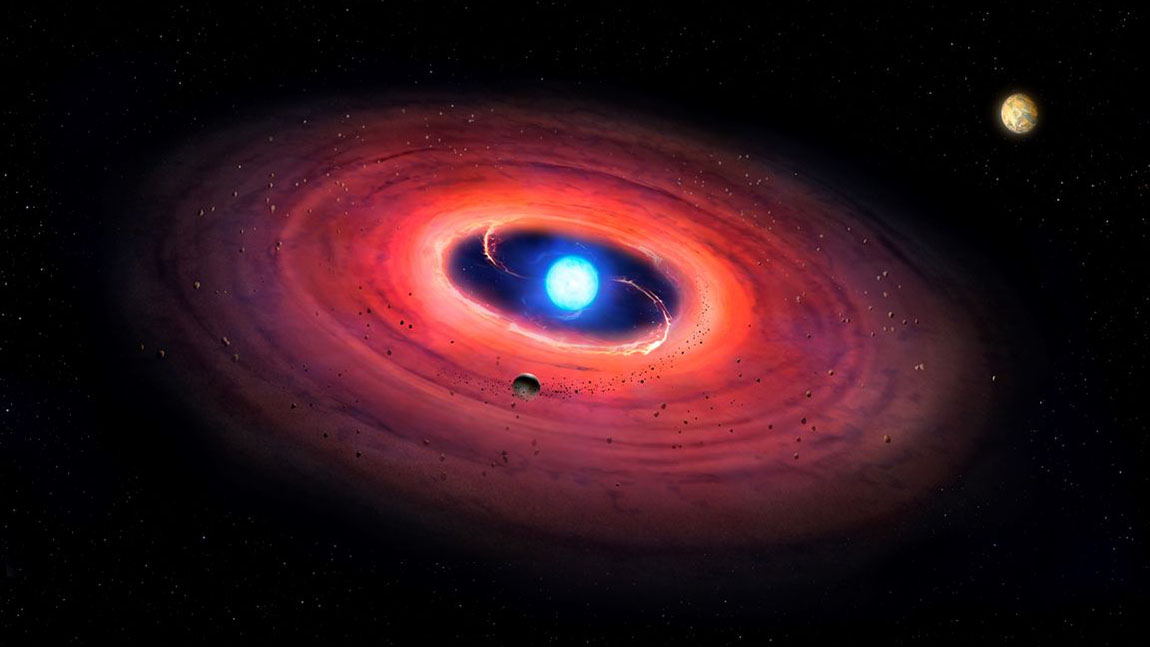a planet four times the size of its star shows how solar systems die

As you no doubt learned in elementary school, stars are big and bright, and planets are dim and small. So, following that basic logic, there’s absolutely no way that one could have a planet four times as big as a star, right? It’s impossible because either the star would be a dud that failed to ever ignite, lacking the mass and heat to do so, or the planet would’ve collapsed under its own gravity and triggered fusion in its core, becoming a star itself. However, there’s a bit of a catch when talking about star sizes. WDJ0914+1914, the poetically named star in question, is a white dwarf, and while it may have once been as large as mighty as our own star, these days, it’s just a faint glimmer of its former self.
You see, white dwarves are the things that some 99.5% of all stars become when they run out of fuel and burn through their remaining stores of energy until they become spheres of carbon or enormous diamonds. Lacking the vast, convecting envelopes of dense plasma produced by constant fusion, typical white dwarfs shrink to become only a bit bigger than our planet in size. Of course, you couldn’t just go for a stroll on its surface. It’s would still almost as massive as the Sun and searing hot at the surface, so if you somehow survive dealing with more than 20 times the gravitational pull at its crust, the 28,000 °C temperatures would almost instantly turn you into a cloud of charged particles.
And that brings us back to the gas giant orbiting WDJ0914+1914 about 1,500 light years away in the Cancer constellation. It appears that as the star fizzled out and shed its outer layers, likely destroying any world in close orbit, it formed a disk of hydrogen, oxygen, and sulfur. As the surviving planet plowed through the material, it must have lost energy and drifted to within just a million or so kilometers of the glowing ember of its parent star. Sadly, this isn’t ideal at the moment since the high energy photons from the white dwarf are stripping some 3,000 tons of material from this gas giant every second, but this seemingly dire state of affairs is actually both temporary and ultimately inconsequential.
Over the next 350 million years, it will rapidly stop losing mass and survive almost unscathed. While 3,000 tons per second might seem like a lot at first glance, it really isn’t when you more than 100 sextillion tons to spare and know the rate of loss is bound to fall over time and end with only a few hundredth of your total mass sapped away. It won’t even noticeably affect either the size or gravity of the planet. Its orbit will decay a little further, but after this period of intense bombardment, it will spend the next two billion years around a stellar remnant cooling to what’s known as a black dwarf, the aforementioned ball of carbon that no longer emits any notable heat or light, and for which fusion creating new elements is just a distant memory.
So, imagine a planet much like Neptune whirring around a white-hot ball the size of Earth, plowing through a disk of swirling dust about 14 million kilometers across and that’s more or less the WDJ0914+1914 system. Mangled and distorted but surviving, and finally providing us with confirmation that white dwarfs could play host to solar systems, as indicated by previous observations of smaller stellar objects colliding with them to create similar disks of dust and debris. Ultimately, whether a solar system survives a transition from star to white dwarf and what the end result looks depends on the star itself. But at least we now know that planets can survive the death of their suns if they have enough mass and obit far enough away.
See: Gänsicke, B.T., et al. Accretion of a giant planet onto a white dwarf star. Nature 576, 61–64 (2019) DOI: 10.1038/s41586-019-1789-8





